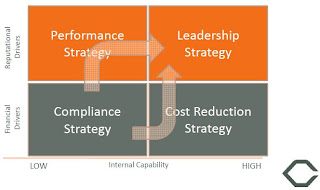We may have weeks or months to wait before DECC publishes the results of the legislative consultation. However, it would be a mistake for companies to wait until the final legislation is published before taking action. As I noted in a previous post, the original Carbon Reduction Commitment rules were only finalised a month before the legislation came into force. Firms that fail to prepare in advance will find themselves at a disadvantage when it comes to complying with the new carbon reporting rules.
So what can companies do to get ready?
Many firms that need to report their carbon footprint make the mistake of leaping immediately into the data collection phase without specifying how they plan to use the resultant information. In many cases, this approach yields a carbon footprint report that fails to generate broader benefits for the company.
We recommend that businesses take a more focused approach if they wish to get long-term value from their carbon reporting efforts. The first step in this approach is to determine the correct measurement and reporting strategy to pursue. The measurement and reporting strategy will help dictate the human and financial resources the firm allocates to the initiative, the software and other data collection systems that will be employed to process the information, and even how the company will be able to communicate its accomplishments.
So what questions must the reporting team answer to determine their carbon measurement strategy? One of the key issues is to understand the types of benefits the company expects to gain from their carbon reporting. Is the main driver the promise of financial savings that result from better management of corporate resources, or does the business also expect to reap reputational rewards from their carbon disclosure? A logistics business focused on cost savings might go beyond the legislation to collect very fine-grained data on their fleet using a telematics solution, and then drive efficiencies through driver education. Meanwhile, a consumer facing retailer seeking reputational benefits might go beyond the requirements of the legislation in a different way and report voluntarily on a broader range of activities in its supply chain. Each of these decisions has implications for the types of data a company chooses to collect, and the data collection tools and systems it uses to assemble this information.
Another key consideration in the determination of a company's carbon measurement and reporting strategy is the internal implementation capacity of the business. Even with the best will in the world, a company that is unable to devote technical, financial and human resources to carbon measurement cannot achieve as much as one with a larger, more experienced team and proportionately greater budget. Understanding your resources, capabilities and limitations can help prevent over-reach and potential underperformance.
What you need, then, is an approach that is tailored to your company. Carbon Clear has been helping firms determine their carbon measurement and reporting strategy, both in terms of the benefits they can reasonably expect to achieve and in terms of their internal capability to roll out their reporting initiative.
Among other things, these basic criteria allow us to create a rough snapshot that plots corporate carbon measurement strategies within four quadrants, as shown below:
 | |
| Carbon Measurement & Reporting Strategy Quadrants | (Copyright Carbon Clear, all rights reserved) |
Every business needs a carbon measurement and reporting approach customised to their requirements. However, we have found that this snapshot helps companies focus on the issues most relevant to their position, while avoiding the one-size-fits-all approach of some solution providers.
Companies that pursue a "Compliance" strategy tend to have limited internal capacity to implement a sophisticated measurement programme and see little reputational benefit from reporting their carbon data (perhaps because they are not consumer-facing a consumer-facing brand or anticipate limited investor pressure for carbon disclosure). Firms in the "Compliance Quadrant" tend to follow the letter of the law. Their primary objective is to avoid any negative repercussions that result from failure to meet the legislation's requirements. Financial savings that result from better data and efficiency improvements are secondary. These businesses may use a simple carbon accounting software package or even a spreadsheet tool to calculate their carbon footprint.
Like their "Compliance" counterparts, firms in the lower-right "Cost Reduction" Quadrant lack strong reputational drivers for developing their footprint measurement and reporting system. However, their strong internal implementation capability (budget, staff, management systems) means they are better able to use more sophisticated carbon accounting diagnostic tools to identify emissions hot-spots and drive footprint and cost reductions.
The upper-left quadrant, housing Performance Strategy firms, is for companies that face brand or reputational pressure to disclose their carbon performance, but who have limited ability to put in place a sophisticated measurement and reporting system. These companies may choose to start with a basic carbon footprint report and embark on a programme of continuous improvement, that encompasses ambitious overall reduction targets. In most cases, these firms will try to capture more and more of their total footprint as their data management capability improves over time.
Companies that stand to gain brand and reputational benefits from carbon measurement and reporting, and that have the internal capability to implement a robust data collection and management programme may find themselves in the "Leadership Strategy" Quadrant. These firms want to use their carbon reporting to demonstrate to stakeholders their commitment to environmental sustainability, achieve a high score at the top of the CDP and carbon maturity league tables, and use their carbon reporting initiative as a vehicle to engage their staff, their customers and, increasingly, their investors. They may use more sophisticated carbon accounting tools that integrate with their accounting system and capture data for a range of other sustainability indicators at the same time.
Many companies that begin in the "Compliance", "Cost Reduction" or "Performance" quadrants may move to the "Leadership" strategy quadrant as their systems improve and as the broader benefits of carbon reporting and management become evident. However, it isn't necessary to begin there, and many firms may be comfortable staying where they are. What it shows, however, is that there is no "one-size fits all" approach to carbon reporting.
Choosing the right carbon measurement and reporting strategy is the first step in preparing a fit-for-purpose carbon footprint report. Getting it right requires a thorough evaluation of your company's business drivers and of your internal resources and capabilities.
These decisions will influence every other aspect of your company's response to Mandatory Carbon Reporting, so it is important to know where you stand. The good news is that you don't have to wait for DECC to release the final details around the carbon reporting legislation before you determine the right approach. We have already begun helping companies define carbon reporting strategies that range from compliance to competitive advantage, ensuring that they spend resources wisely and helping identify business benefits.


